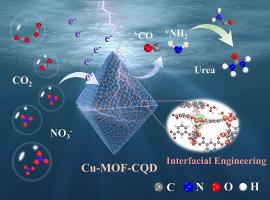碳量子点/金属有机骨架异质结构在二氧化碳和硝酸盐催化尿素电合成中的界面工程研究。
IF 9.7
1区 化学
Q1 CHEMISTRY, PHYSICAL
引用次数: 0
摘要
从CO2和NO3-中电催化合成尿素为传统的能源密集型工业过程提供了一种可持续的替代方案。然而,CN耦合动力学迟缓和CO2/NO3-还原速率不匹配仍然阻碍了它的发展。本文通过超声-静态一步法将富氨基的碳量子点(CQDs)/金属有机骨架(MOF)异质结构(Cu-MOF-CQD)整合到多孔的Cu-BTC骨架(BTC = 1,3,5-苯三羧酸)中。CQDs的集成显著提高了Cu- mof的电导率,并通过CQDs表面基团与Cu- mof内不饱和Cu位点的相互作用调节了Cu- mof的界面电子结构,从而富集了高价Cu物质,促进了电荷转移。Operando光谱表征结合密度泛函理论计算揭示了Cu-MOF-CQD的界面效应为*COOH到*CO的转化提供了更强的驱动力,加速了*CO和*NH2中间体的耦合,从而促进了CN键的高效形成。得益于这一协同界面,Cu-MOF- cqd在-0.5 V条件下的尿素法拉第效率为18.5±0.7%,尿素产率为260.2±10.1 μg h-1 mgcat-1,优于原始Cu-MOF。本研究建立了一种可推广的零维碳/MOF异质结构提高CN偶联性能的策略,为可持续CN偶联反应的下一代电催化剂的设计提供了新的原则。本文章由计算机程序翻译,如有差异,请以英文原文为准。

Interfacial engineering of carbon quantum dot/metal-organic framework heterostructures for boosted urea electrosynthesis from carbon dioxide and nitrate
Electrocatalytic urea synthesis from CO2 and NO3− offers a sustainable alternative to conventional energy-intensive industrial processes. However, it remains hindered by sluggish C![]() N coupling kinetics and mismatched CO2/NO3− reduction rates. Herein, a carbon quantum dots (CQDs)/metal-organic framework (MOF) heterostructure (Cu-MOF-CQD) was constructed by integrating amino-rich CQDs into the porous Cu-BTC framework (BTC = 1,3,5-benzenetricarboxylic acid) via a one-step ultrasonic-static strategy. The integration of CQDs markedly enhances the electrical conductivity of Cu-MOF and modulates the interfacial electronic structure through interactions between CQDs surface groups and unsaturated Cu sites within Cu-MOF, thereby enriching high-valence Cu species and facilitating charge transfer. Operando spectroscopic characterizations combined with density functional theory calculations unveil that the interface effect of Cu-MOF-CQD provides a stronger driving force for *COOH to *CO conversion and accelerates the coupling of *CO and *NH2 intermediates, thus promoting efficient C
N coupling kinetics and mismatched CO2/NO3− reduction rates. Herein, a carbon quantum dots (CQDs)/metal-organic framework (MOF) heterostructure (Cu-MOF-CQD) was constructed by integrating amino-rich CQDs into the porous Cu-BTC framework (BTC = 1,3,5-benzenetricarboxylic acid) via a one-step ultrasonic-static strategy. The integration of CQDs markedly enhances the electrical conductivity of Cu-MOF and modulates the interfacial electronic structure through interactions between CQDs surface groups and unsaturated Cu sites within Cu-MOF, thereby enriching high-valence Cu species and facilitating charge transfer. Operando spectroscopic characterizations combined with density functional theory calculations unveil that the interface effect of Cu-MOF-CQD provides a stronger driving force for *COOH to *CO conversion and accelerates the coupling of *CO and *NH2 intermediates, thus promoting efficient C![]() N bond formation. Benefiting from this synergistic interface, in a flow cell, Cu-MOF-CQD achieves a maximum urea Faradaic efficiency of 18.5 ± 0.7 % at −0.5 V vs. RHE and the corresponding urea yield rate of 260.2 ± 10.1 μg h−1 mgcat−1, surpassing the performance of pristine Cu-MOF. This work establishes a generalizable strategy of zero-dimensional carbon/MOF heterostructures for boosting C
N bond formation. Benefiting from this synergistic interface, in a flow cell, Cu-MOF-CQD achieves a maximum urea Faradaic efficiency of 18.5 ± 0.7 % at −0.5 V vs. RHE and the corresponding urea yield rate of 260.2 ± 10.1 μg h−1 mgcat−1, surpassing the performance of pristine Cu-MOF. This work establishes a generalizable strategy of zero-dimensional carbon/MOF heterostructures for boosting C![]() N coupling performance, offering new design principles for next-generation electrocatalysts in sustainable C
N coupling performance, offering new design principles for next-generation electrocatalysts in sustainable C![]() N coupling reactions.
N coupling reactions.
求助全文
通过发布文献求助,成功后即可免费获取论文全文。
去求助
来源期刊
CiteScore
16.10
自引率
7.10%
发文量
2568
审稿时长
2 months
期刊介绍:
The Journal of Colloid and Interface Science publishes original research findings on the fundamental principles of colloid and interface science, as well as innovative applications in various fields. The criteria for publication include impact, quality, novelty, and originality.
Emphasis:
The journal emphasizes fundamental scientific innovation within the following categories:
A.Colloidal Materials and Nanomaterials
B.Soft Colloidal and Self-Assembly Systems
C.Adsorption, Catalysis, and Electrochemistry
D.Interfacial Processes, Capillarity, and Wetting
E.Biomaterials and Nanomedicine
F.Energy Conversion and Storage, and Environmental Technologies

 求助内容:
求助内容: 应助结果提醒方式:
应助结果提醒方式:


